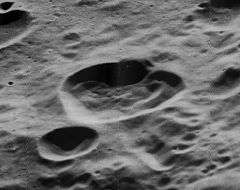Lovell (crater)
Lovell is a small lunar impact crater that lies across the eastern edge of the walled plain Apollo, on the far side of the Moon. It has a somewhat irregular shape, with outward bulges to the north and west. The rim is sharp-edged, with some slight wear along the northwestern bend. The featureless inner walls slope directly down to the uneven interior floor.
 Oblique Lunar Orbiter 5 image | |
| Coordinates | 36.8°S 141.9°W |
|---|---|
| Diameter | 34 km |
| Depth | Unknown |
| Colongitude | 143° at sunrise |
| Eponym | Jim Lovell |

Lovell crater is named after the American astronaut Jim Lovell, crew member of the Apollo 8 mission in 1968, which was the first crewed mission to the Moon. Two nearby craters are named after the other two crew members, Frank Borman (Borman crater) and William Anders (Anders crater).[1]
Satellite craters
By convention these features are identified on lunar maps by placing the letter on the side of the crater midpoint that is closest to Lovell.
| Lovell | Latitude | Longitude | Diameter |
|---|---|---|---|
| F | 36.7° S | 138.2° W | 24 km |
| R | 37.7° S | 144.0° W | 24 km |
References
- Andersson, L. E.; Whitaker, E. A. (1982). NASA Catalogue of Lunar Nomenclature. NASA RP-1097.CS1 maint: ref=harv (link)
- Blue, Jennifer (July 25, 2007). "Gazetteer of Planetary Nomenclature". USGS. Retrieved 2007-08-05.CS1 maint: ref=harv (link)
- Bussey, B.; Spudis, P. (2004). The Clementine Atlas of the Moon. New York: Cambridge University Press. ISBN 978-0-521-81528-4.CS1 maint: ref=harv (link)
- Cocks, Elijah E.; Cocks, Josiah C. (1995). Who's Who on the Moon: A Biographical Dictionary of Lunar Nomenclature. Tudor Publishers. ISBN 978-0-936389-27-1.CS1 maint: ref=harv (link)
- McDowell, Jonathan (July 15, 2007). "Lunar Nomenclature". Jonathan's Space Report. Retrieved 2007-10-24.CS1 maint: ref=harv (link)
- Menzel, D. H.; Minnaert, M.; Levin, B.; Dollfus, A.; Bell, B. (1971). "Report on Lunar Nomenclature by the Working Group of Commission 17 of the IAU". Space Science Reviews. 12 (2): 136–186. Bibcode:1971SSRv...12..136M. doi:10.1007/BF00171763.CS1 maint: ref=harv (link)
- Moore, Patrick (2001). On the Moon. Sterling Publishing Co. ISBN 978-0-304-35469-6.CS1 maint: ref=harv (link)
- Price, Fred W. (1988). The Moon Observer's Handbook. Cambridge University Press. ISBN 978-0-521-33500-3.CS1 maint: ref=harv (link)
- Rükl, Antonín (1990). Atlas of the Moon. Kalmbach Books. ISBN 978-0-913135-17-4.CS1 maint: ref=harv (link)
- Webb, Rev. T. W. (1962). Celestial Objects for Common Telescopes (6th revised ed.). Dover. ISBN 978-0-486-20917-3.CS1 maint: ref=harv (link)
- Whitaker, Ewen A. (1999). Mapping and Naming the Moon. Cambridge University Press. ISBN 978-0-521-62248-6.CS1 maint: ref=harv (link)
- Wlasuk, Peter T. (2000). Observing the Moon. Springer. ISBN 978-1-85233-193-1.CS1 maint: ref=harv (link)
- McElheny, Victor K. (August 15, 1970). "Armstrong, Aldrin, Collins on Moon again–as Names". The Boston Globe. Boston, Massachusetts. p. 16 – via Newspapers.com.